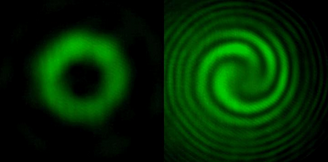
Complex States of Light Generated via Metasurface
source:Photonics
release:Nick
keywords: Metasurface; states of light; Optics
Time:2017-11-09
CAMBRIDGE, Mass., Nov. 7, 2017 — Researchers have designed a method for converting arbitrary spin angular momentum (SAM) states of light into total angular momentum states. This method is characterized by the superposition of independent orbital angular momentum (OAM) and could lead to the generation of novel states of light for research and applications.
Researchers at the Harvard John A. Paulson School of Engineering and Applied Sciences (SEAS) developed a metasurface that converts left- and right-circular polarizations into states with independent values of OAM. The team designed an additional device that performs the same operation for elliptically polarized states. The research shows the potential for a material-mediated connection between the SAM and OAM states of light.
A metasurface uses circularly polarized light to generate and control new and complex states of light, such as swirling vortices. The tool can be used to develop new applications for structured light. Courtesy of Second Bay Studio/Harvard SEAS.
“We have developed a metasurface [that] is a new tool to study novel aspects of light,” said professor Federico Capasso. “This optical component makes possible much more complex operations and allows researchers to not only explore new states of light but also new applications for structured light.”
Using the metasurface, any polarization input can result in any OAM output. Thus, any polarization can yield any kind of structured light, from spirals and corkscrews to vortices of any size. The device can be programmed to produce one vortex from one polarization and a different vortex from another polarization.
“This metasurface gives the most general connection, through a single device, between the orbital momentum and polarization of light that’s been achieved so far,” said researcher Robert Devlin.
Arbitrary spin-to-OAM conversion of light could be used in optical communications and other applications that use structured light. One potential application is in the area of optical tweezers, which use light to move molecules. The orbital momentum of light is strong enough to make microscopic particles rotate and move.
“This is a completely new optical component,” said Antonio Ambrosio, principal scientist at Harvard Center for Nanoscale Systems (CNS). “Some metasurfaces are iterations or more efficient, more compact versions of existing optical devices, but this arbitrary spin-to-orbital conversion cannot be done with any other optical device. There is nothing in nature as well that can do this and produce these states of light.”
Another application could be in the area of high-powered imaging. The polarization of light could be adjusted to image features smaller than the diffraction limit.
A metasurface can generate strange new beams of light that swirl and corkscrew. The black hole in the center of these vortices can be used to image features smaller than half a wavelength of light or move tiny molecules. Courtesy of the Capasso Lab/Harvard SEAS.
“You can imagine, if we illuminate the device with one polarization of light, it will create a force of a particular kind,” said Ambrosio. “Then, if you want to change the force, all you need to do is change the polarization of the incoming light. The force is directly related to the design of the device.”
The complex light structures generated by the metasurface could also be used to explore questions of fundamental physics.

- RoboSense is to Produce the First Chinese Multi-beam LiDAR
- China is to Accelerate the Development of Laser Hardening Application
- Han’s Laser Buys Canadian Fiber Specialist CorActive
- SPI Lasers continues it expansion in China, appointing a dedicated Sales Director
- Laser Coating Removal Robot for Aircraft
 FISBA exhibits Customized Solutions for Minimally Invasive Medical Endoscopic Devices at COMPAMED in
FISBA exhibits Customized Solutions for Minimally Invasive Medical Endoscopic Devices at COMPAMED in New Active Alignment System for the Coupling of Photonic Structures to Fiber Arrays
New Active Alignment System for the Coupling of Photonic Structures to Fiber Arrays A new industrial compression module by Amplitude
A new industrial compression module by Amplitude Menhir Photonics Introduces the MENHIR-1550 The Industry's First Turnkey Femtosecond Laser of
Menhir Photonics Introduces the MENHIR-1550 The Industry's First Turnkey Femtosecond Laser of Shenzhen DNE Laser introduced new generation D-FAST cutting machine (12000 W)
more>>
Shenzhen DNE Laser introduced new generation D-FAST cutting machine (12000 W)
more>>


